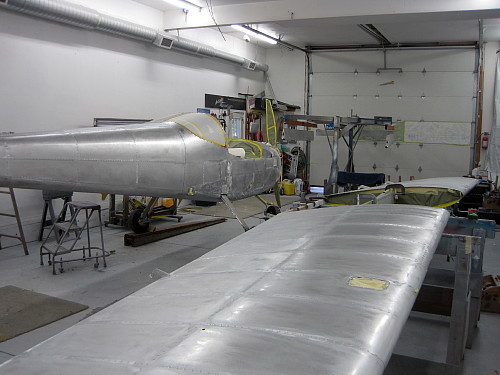Promised Wingamajig pics
Here are the promised pictures of my Wingamajig. As previously posted, such a jig can be easily replaced with a couple of saw horses and C clamps, IF you have plenty of space in your paint booth. Since my booth also my garage, I don't have that luxury, and thus resorted to this:
This is the rotor/sleeve assembly. The sleeve consists of two outside layers of plywood, approximately 9 x 45", and two inner plys of 3/4" and 1/4" cut to accept the tapered spar with a little wiggle room. The spar end attaches to the original engine mount rotor.
This is the wing root end of the rotor with 1-1/2" hole for the spar pin, and spring clip to hold it in place. the end of sleeve has corners trimmed to allow clearance for spraying the skins adjacent to the spar.
Additions to the Harbor Freight engine stand. 4-inch steel wheels replaced with 8" wheels to raise that end of the engine mount higher, to level the axis of rotation, and ease moving over the threshold of the garage/paint booth. Two 4-ft 2x10s, were bolted to the bottom cross-members of the engine stand, with a 2x8" skirt on the side. A 2x4 was placed on the back also, in anticipation of needing to add counterweight-turns out none needed.
Two ten-foot 2x4s were added to assure no CG issues the 2x4s are slid inside and bolted to the 2x8 skirts and the angle between them adjusted to achieve the proper height of the wing above the jig's supporting 2x4s. Two 4" locking swivel casters were placed on the ends of the 2x4s.
Details of the main bearing--a sandwich of 2x4s between plywood was created to hold two 5" caster wheels. The end of the 2x4s is about 72" from the wing root--for this heavy-ended jig, no CG problems were seen. A much simpler design which gets the casters elevated to the proper height and angles is possible--this was just and evolutionary mistake that can be corrected in other builder's creative cycle.
Start of the wing-sling to Wingamajig loading process--the sling is moved into position and the end of the wing spar inserted into the sleeve end. I removed the brass bushings from the wing spars to give easier clearance and to avoid any damage to the bushings.
The end of the wing is then lifted and the spar shoved all the way into the sleeve: Both spar pins are then inserted and held in place with some spring clips (available from Home Depot Aerospace Dept). The wing sling is removed and we have a cantilevered wing stand! Rube Goldberg would be delighted!
Using the handle on the end of the engine stand, the wing can be turned through about 270 degrees, and held in place at 45-degree increments by the pin in the engine stand rotor. Here is the wing in a horizontal/upside down configuration:
And here is a fuzzy picture of in rotated to its extreme for the trailing-edge down position:















